Abstract
We have previously shown that the hepoxilins are capable of increasing the intracellular free concentration of calcium ([Ca2+]i) in human neutrophils through a pertussis toxin-sensitive, extracellular calcium-independent pathway involving the mobilization of calcium from internal stores. A subsequent hepoxilin-induced and extracellular calcium-dependent influx of calcium is observed. In an effort to investigate further the role of these compounds in the human neutrophil, we investigated their potential effects on the action of known agonists such as formyl-methionine-leucine-phenylalanine (fMLP), platelet-activating factor (PAF) and leukotriene B4 (LTB4) on the mobilization of calcium. Hepoxilis dose-dependently inhibited the increases in [Ca2+]i induced by fMLP, PAF and LTB4. The hepoxilin concentration required for inhibition was around 100 ng/ml (3 x 10(-7) M). This concentration of hepoxilin did not cause any measurable change in [Ca2+]i. The extent of inhibition of the agonist-evoked rise in [Ca2+]i by hepoxilins was proportional to the increase in the calcium response evoked by hepoxilin beyond its threshold concentration. Additional experiments were carried out to investigate the mechanism for the hepoxilin effect. Using calcium-free medium and in the presence of sufficient amounts of thapsigargin (200 ng/ml) to maximally block the calcium pump (thereby achieving a constant rate of calcium leakage from stores), hepoxilin A3 increased further this rate of calcium leakage, indicating that hepoxilin acts by rapidly draining calcium from stores. Its potential (additional) thapsigargin-like action in blocking the pump, however, cannot be ruled out by these experiments. These observations suggest that the hepoxilins may serve an important negative regulatory function in the agonist-induced mobilization of calcium in these cells by depleting calcium stores.
Full text
PDF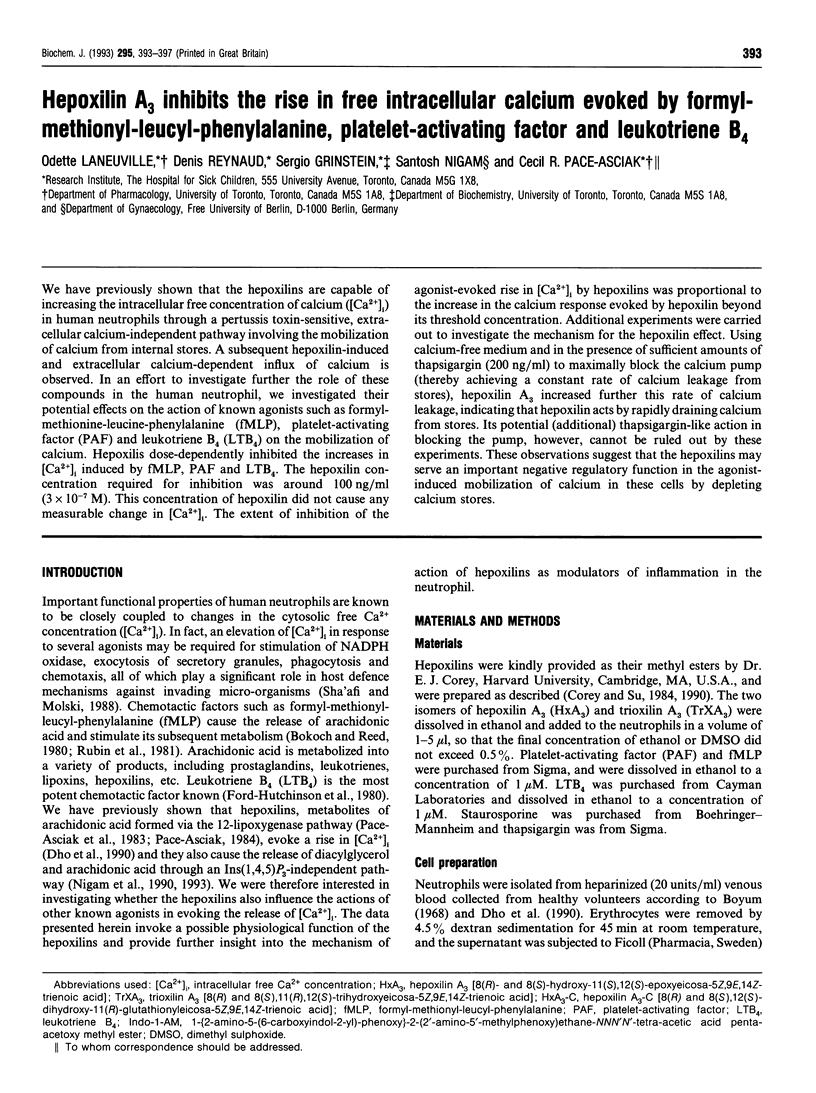
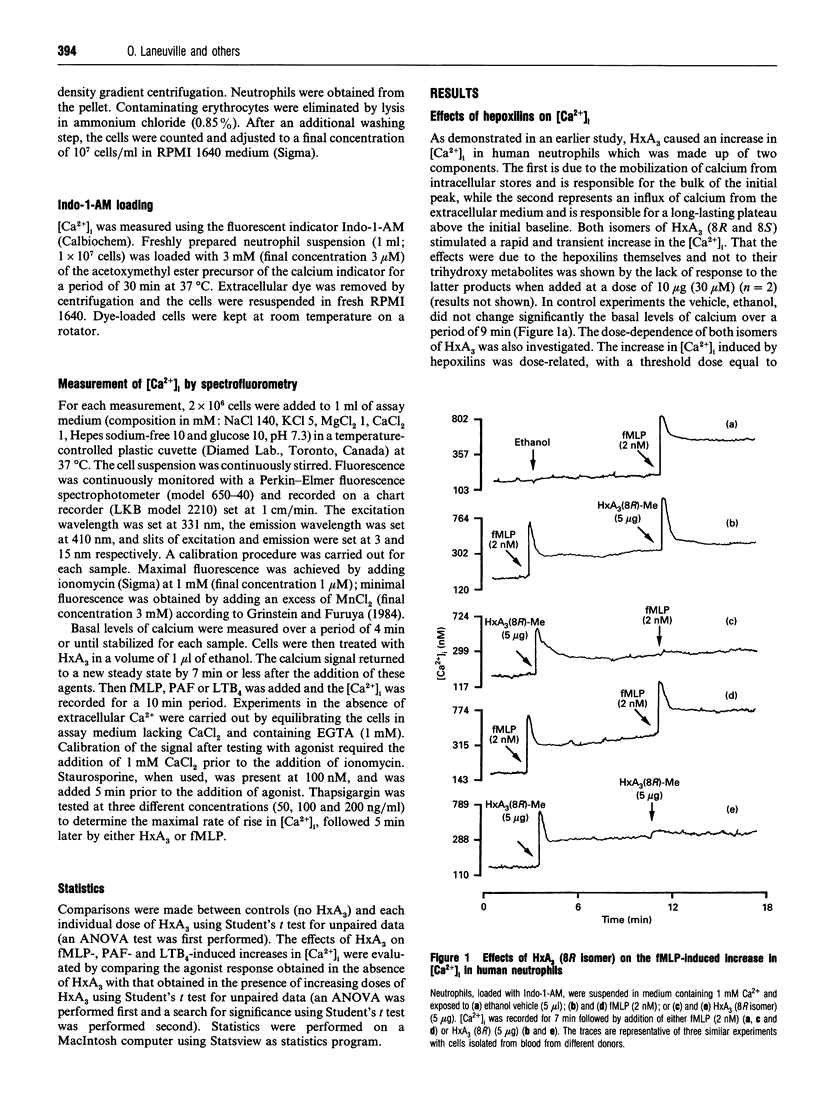
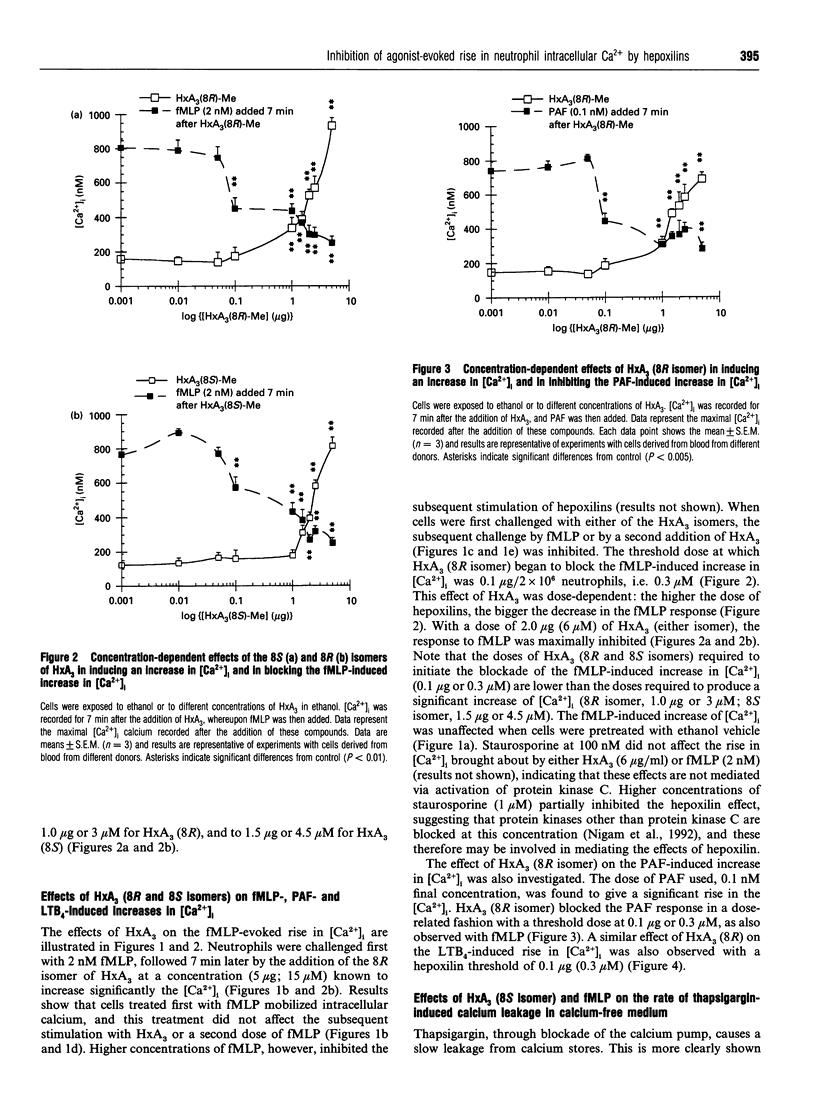
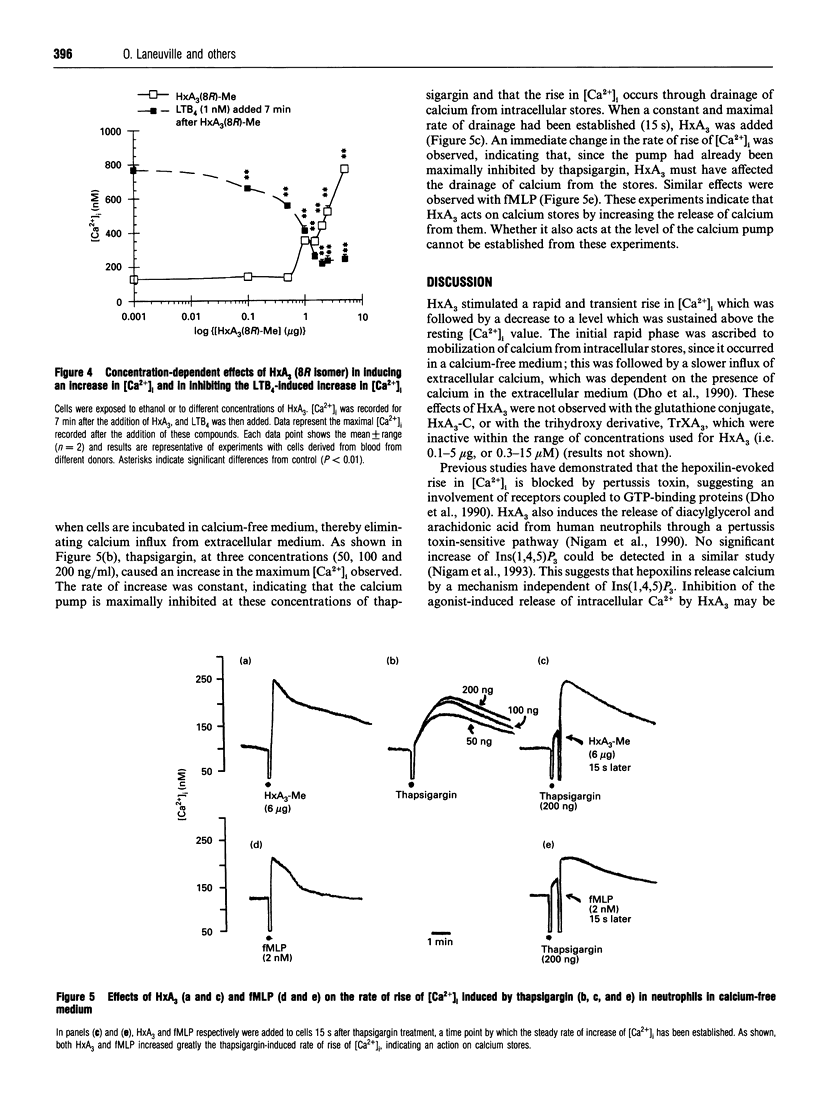
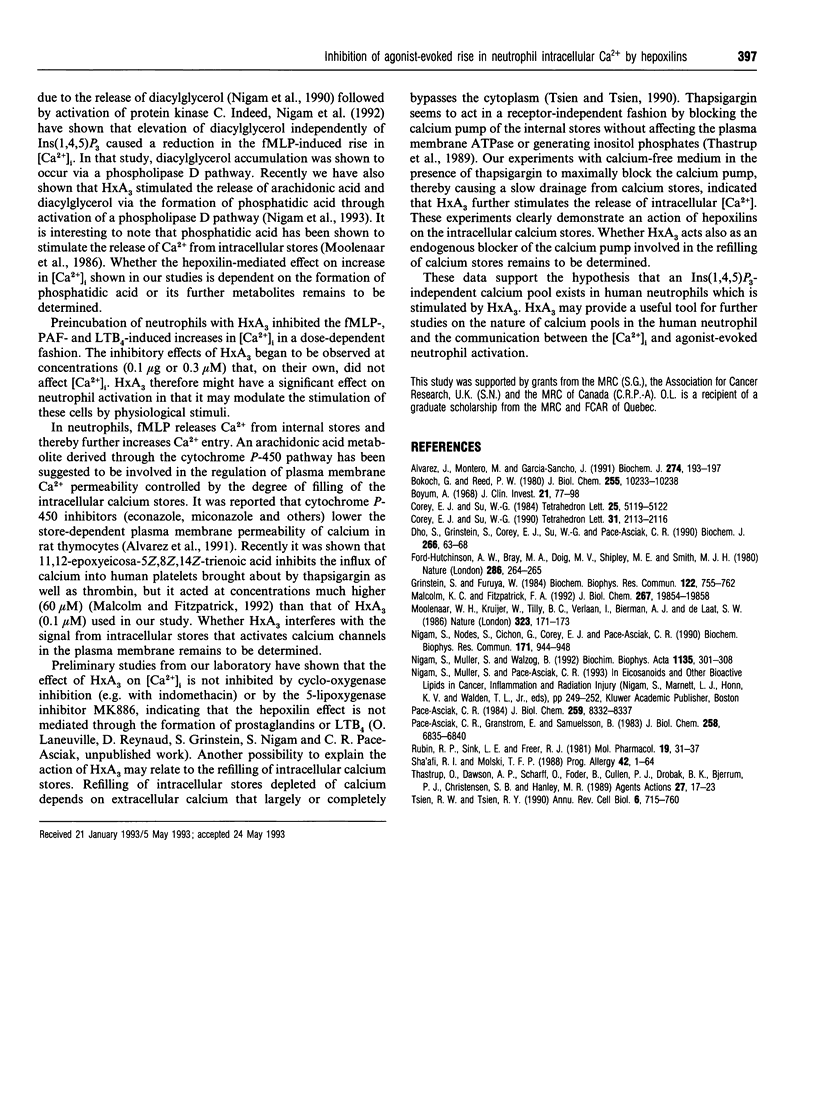
Selected References
These references are in PubMed. This may not be the complete list of references from this article.
- Alvarez J., Montero M., García-Sancho J. Cytochrome P-450 may link intracellular Ca2+ stores with plasma membrane Ca2+ influx. Biochem J. 1991 Feb 15;274(Pt 1):193–197. doi: 10.1042/bj2740193. [DOI] [PMC free article] [PubMed] [Google Scholar]
- Böyum A. Isolation of mononuclear cells and granulocytes from human blood. Isolation of monuclear cells by one centrifugation, and of granulocytes by combining centrifugation and sedimentation at 1 g. Scand J Clin Lab Invest Suppl. 1968;97:77–89. [PubMed] [Google Scholar]
- Dho S., Grinstein S., Corey E. J., Su W. G., Pace-Asciak C. R. Hepoxilin A3 induces changes in cytosolic calcium, intracellular pH and membrane potential in human neutrophils. Biochem J. 1990 Feb 15;266(1):63–68. doi: 10.1042/bj2660063. [DOI] [PMC free article] [PubMed] [Google Scholar]
- Ford-Hutchinson A. W., Bray M. A., Doig M. V., Shipley M. E., Smith M. J. Leukotriene B, a potent chemokinetic and aggregating substance released from polymorphonuclear leukocytes. Nature. 1980 Jul 17;286(5770):264–265. doi: 10.1038/286264a0. [DOI] [PubMed] [Google Scholar]
- Grinstein S., Furuya W. Amiloride-sensitive Na+/H+ exchange in human neutrophils: mechanism of activation by chemotactic factors. Biochem Biophys Res Commun. 1984 Jul 31;122(2):755–762. doi: 10.1016/s0006-291x(84)80098-4. [DOI] [PubMed] [Google Scholar]
- Malcolm K. C., Fitzpatrick F. A. Epoxyeicosatrienoic acids inhibit Ca2+ entry into platelets stimulated by thapsigargin and thrombin. J Biol Chem. 1992 Oct 5;267(28):19854–19858. [PubMed] [Google Scholar]
- Moolenaar W. H., Kruijer W., Tilly B. C., Verlaan I., Bierman A. J., de Laat S. W. Growth factor-like action of phosphatidic acid. Nature. 1986 Sep 11;323(6084):171–173. doi: 10.1038/323171a0. [DOI] [PubMed] [Google Scholar]
- Nigam S., Müller S., Walzog B. Effect of staurosporine on fMet-Leu-Phe-stimulated human neutrophils: dissociated release of inositol 1,4,5-trisphosphate, diacylglycerol and intracellular calcium. Biochim Biophys Acta. 1992 Jun 29;1135(3):301–308. doi: 10.1016/0167-4889(92)90235-4. [DOI] [PubMed] [Google Scholar]
- Nigam S., Nodes S., Cichon G., Corey E. J., Pace-Asciak C. R. Receptor-mediated action of hepoxilin A3 releases diacylglycerol and arachidonic acid from human neutrophils. Biochem Biophys Res Commun. 1990 Sep 28;171(3):944–948. doi: 10.1016/0006-291x(90)90775-i. [DOI] [PubMed] [Google Scholar]
- Pace-Asciak C. R. Arachidonic acid epoxides. Demonstration through [18O]oxygen studies of an intramolecular transfer of the terminal hydroxyl group of (12S)-hydroperoxyeicosa-5,8,10,14-tetraenoic acid to form hydroxyepoxides. J Biol Chem. 1984 Jul 10;259(13):8332–8337. [PubMed] [Google Scholar]
- Pace-Asciak C. R., Granström E., Samuelsson B. Arachidonic acid epoxides. Isolation and structure of two hydroxy epoxide intermediates in the formation of 8,11,12- and 10,11,12-trihydroxyeicosatrienoic acids. J Biol Chem. 1983 Jun 10;258(11):6835–6840. [PubMed] [Google Scholar]
- Rubin R. P., Sink L. E., Freer R. J. On the relationship between formylmethionyl-leucyl-phenylalanine stimulation of arachidonyl phosphatidylinositol turnover and lysosomal enzyme secretion by rabbit neutrophils. Mol Pharmacol. 1981 Jan;19(1):31–37. [PubMed] [Google Scholar]
- Sha'afi R. I., Molski T. F. Activation of the neutrophil. Prog Allergy. 1988;42:1–64. doi: 10.1159/000318681. [DOI] [PubMed] [Google Scholar]
- Thastrup O., Dawson A. P., Scharff O., Foder B., Cullen P. J., Drøbak B. K., Bjerrum P. J., Christensen S. B., Hanley M. R. Thapsigargin, a novel molecular probe for studying intracellular calcium release and storage. Agents Actions. 1989 Apr;27(1-2):17–23. doi: 10.1007/BF02222186. [DOI] [PubMed] [Google Scholar]
- Tsien R. W., Tsien R. Y. Calcium channels, stores, and oscillations. Annu Rev Cell Biol. 1990;6:715–760. doi: 10.1146/annurev.cb.06.110190.003435. [DOI] [PubMed] [Google Scholar]


